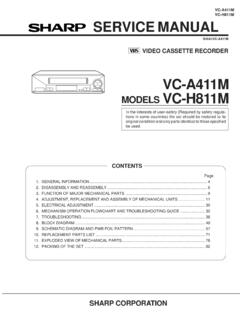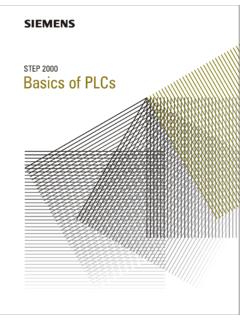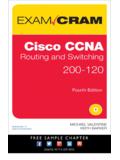Transcription of Basics of PLCs - Diagramas de
1 STEP 2000 Basics of PLCs1 Table of ContentsIntroduction ..2 plcs ..4 Number .. 14 Basic Micro plcs ..28 Connecting External A PLC ..41 Discrete Inputs/Outputs ..49 Analog Inputs and .. 71 High-Speed Instructions ..75 Specialized Expansion Modules ..78 Review Answers ..84 Final Exam ..852 IntroductionWelcome to another course in the STEP 2000 series, Siemens Technical Education Program, designed to prepare our distributors to sell Siemens Energy & Automation products more effectively. This course covers Basics of plcs and related products. Upon completion of Basics of plcs you should be able to: Identify the major components of a PLC and describe their functions Convert numbers from decimal to binary , BCD, and hexadecimal Identify typical discrete and analog inputs and outputs Read a basic ladder logic diagram and statement list Identify operational differences between different S7-200 models Identify the proper manual to refer to for programming or installation of an S7-200 PLC Connect a simple discrete input and output to an S7-200 Select the proper expansion module for analog inputs and outputs Describe the operation of timers and counters3 This knowledge will help you better understand customer applications.
2 In addition, you will be better able to describe products to customers and determine important differences between products. You should complete Basics of Electricity before attempting Basics of plcs . An understanding of many of the concepts covered in Basics of Electricity is required for Basics of plcs . In addition you may wish to complete Basics of Control Components. Devices covered in Basics of Control Components are used with programmable logic you are an employee of a Siemens Energy & Automation authorized distributor, fill out the final exam tear-out card and mail in the card. We will mail you a certificate of completion if you score a passing grade. Good luck with your , STEP 7, STEP 7-Micro, STEP 7-Micro/WIN, PG 702, and PG 740 are registered trademarks of Siemens Energy & Automation, trademarks are the property of their respective Logic Controllers ( plcs ), also referred to as programmable controllers, are in the computer family.
3 They are used in commercial and industrial applications. A PLC monitors inputs, makes decisions based on its program, and controls outputs to automate a process or machine. This course is meant to supply you with basic information on the functions and configurations of plcs . 5 Basic PLC Operation plcs consist of input modules or points, a Central Processing Unit (CPU), and output modules or points. An input accepts a variety of digital or analog signals from various field devices (sensors) and converts them into a logic signal that can be used by the CPU. The CPU makes decisions and executes control instructions based on program instructions in memory. Output modules convert control instructions from the CPU into a digital or analog signal that can be used to control various field devices (actuators). A programming device is used to input the desired instructions.
4 These instructions determine what the PLC will do for a specific input. An operator interface device allows process information to be displayed and new control parameters to be entered. Pushbuttons (sensors), in this simple example, connected to PLC inputs, can be used to start and stop a motor connected to a PLC through a motor starter (actuator). 6 Hard-Wired Control Prior to plcs , many of these control tasks were solved with contactor or relay controls. This is often referred to as hard-wired control. Circuit diagrams had to be designed, electrical components specified and installed, and wiring lists created. Electricians would then wire the components necessary to perform a specific task. If an error was made the wires had to be reconnected correctly. A change in function or system expansion required extensive component changes and rewiring.
5 OLMCRCRL1T1T2T3L2L3 OLOLOLMMCRMM otorStartStop460 VAC24 VAC12 Advantages of plcs The same, as well as more complex tasks, can be done with a PLC. Wiring between devices and relay contacts is done in the PLC program. Hard-wiring, though still required to connect field devices, is less intensive. Modifying the application and correcting errors are easier to handle. It is easier to create and change a program in a PLC than it is to wire and rewire a are just a few of the advantages of plcs : Smaller physical size than hard-wire solutions. Easier and faster to make changes. plcs have integrated diagnostics and override functions. Diagnostics are centrally available. Applications can be immediately documented. Applications can be duplicated faster and less plcs Siemens makes several PLC product lines in the SIMATIC S7 family.
6 They are: S7-200, S7-300, and S7-400. S7-200 The S7-200 is referred to as a micro PLC because of its small size. The S7-200 has a brick design which means that the power supply and I/O are on-board. The S7-200 can be used on smaller, stand-alone applications such as elevators, car washes, or mixing machines. It can also be used on more complex industrial applications such as bottling and packaging machines. S7-300 and S7-400 The S7-300 and S7-400 plcs are used in more complex applications that support a greater number of I/O points. Both plcs are modular and expandable. The power supply and I/O consist of separate modules connected to the CPU. Choosing either the S7-300 or S7-400 depends on the complexity of the task and possible future expansion. Your Siemens sales representative can provide you with additional information on any of the Siemens SystemsSince a PLC is a computer, it stores information in the form of On or Off conditions (1 or 0), referred to as binary digits (bits).
7 Sometimes binary digits are used individually and sometimes they are used to represent numerical System Various number systems are used by plcs . All number systems have the same three characteristics: digits, base, weight. The decimal system, which is commonly used in everyday life, has the following characteristics:Ten digits 0, 1, 2, 3, 4, 5, 6, 7, 8, 9 Base 10 Weights 1, 10, 100, 1000, .. binary System The binary system is used by programmable controllers. The binary system has the following characteristics:Two digits 0, 1 Base 2 Weights Powers of base 2 (1, 2, 4, 8, 16, ..)In the binary system 1s and 0s are arranged into columns. Each column is weighted. The first column has a binary weight of 20. This is equivalent to a decimal 1. This is referred to as the least significant bit. The binary weight is doubled with each succeeding column.
8 The next column, for example, has a weight of 21, which is equivalent to a decimal 2. The decimal value is doubled in each successive column. The number in the far left hand column is referred to as the most significant bit. In this example, the most significant bit has a binary weight of 27. This is equivalent to a decimal binary The following steps can be used to interpret a decimal to Decimal number from a binary value. 1) Search from least to most significant bit for ) Write down the decimal representation of each column containing a ) Add the column the following example, the fourth and fifth columns from the right contain a 1. The decimal value of the fourth column from the right is 8, and the decimal value of the fifth column from the right is 16. The decimal equivalent of this binary number is 24.
9 The sum of all the weighted columns that contain a 1 is the decimal number that the PLC has the following example the fourth and sixth columns from the right contain a 1. The decimal value of the fourth column from the right is 8, and the decimal value of the sixth column from the right is 32. The decimal equivalent of this binary number is , Bytes, and Words Each binary piece of data is a bit. Eight bits make up one byte. Two bytes, or 16 bits, make up one 0, Logic 1 Programmable controllers can only understand a signal that is On or Off (present or not present). The binary system is a system in which there are only two numbers, 1 and 0. binary 1 indicates that a signal is present, or the switch is On. binary 0 indicates that the signal is not present, or the switch is binary -Coded Decimal (BCD) are decimal numbers where each digit is represented by a four-bit binary number.
10 BCD is commonly used with input and output devices. A thumbwheel switch is one example of an input device that uses BCD. The binary numbers are broken into groups of four bits, each group representing a decimal equivalent. A four-digit thumbwheel switch, like the one shown here, would control 16 (4 x 4) PLC Hexadecimal is another system used in plcs . The hexadecimal system has the following characteristics:16 digits 0, 1, 2, 3, 4, 5, 6, 7, 8, 9, A, B, C, D, E, FBase 16 Weights Powers of base 16 (1, 16, 256, 4096 ..)The ten digits of the decimal system are used for the first ten digits of the hexadecimal system. The first six letters of the alphabet are used for the remaining six = 10 D = 13B = 11 E = 14C = 12 F = 15 The hexadecimal system is used in plcs because it allows the status of a large number of binary bits to be represented in a small space such as on a computer screen or programming device display.








